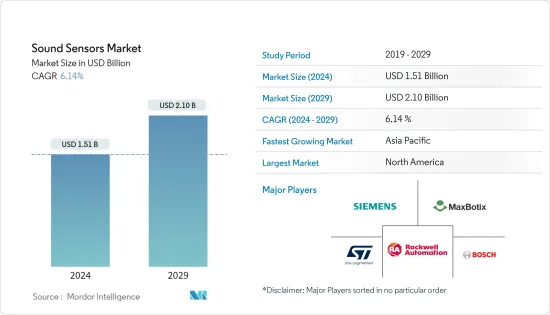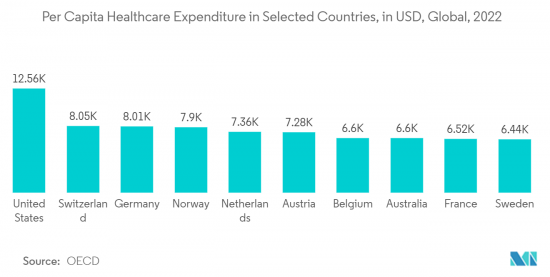PUBLISHER: Mordor Intelligence | PRODUCT CODE: 1404104

PUBLISHER: Mordor Intelligence | PRODUCT CODE: 1404104
Sound Sensors - Market Share Analysis, Industry Trends & Statistics, Growth Forecasts 2024 - 2029

The Sound Sensors Market size is estimated at USD 1.51 billion in 2024, and is expected to reach USD 2.10 billion by 2029, growing at a CAGR of 6.14% during the forecast period (2024-2029).
With emerging applications that have become potential markets for sound sensors, such as autonomous and semi-autonomous self-driving cars and AGVs, the demand for sound sensors is expected to gain momentum in the future.
Key Highlights
- A sound sensor at its core is a sensing module that detects sound waves, usually produced as mechanical vibration of moving air or water molecules, and converts them into electrical signals. A sound sensor's key components include a microphone that detects the sound source, a peak detector, and an audio power amplifier. Sound sensors are primarily adopted in security, switching, and monitoring applications.
- Essential drivers for the growth of this market are the expanding application base for sound sensors and rapid technological advancements. The rising demand for reliable and high-performance sensors in smart home devices is another primary driver that is responsible for the high growth rate of the sound sensors market. Furthermore, investments by major players in developing cost-effective and efficient sensors have also led to miniaturized sensors, which find significant applications in the consumer electronics industry.
- Sound sensors, including acoustic, ultrasound, and audio sensors, have several advantages, like low cost, high sensitivity, and ability to function across many industries. As a result, their adoption has been growing across various sectors. For instance, these sensors are being incorporated into Solar Powered City Pollution Monitor (SPCPM) systems, which can help monitor sound quality in the city, as sound pollution is a growing concern nowadays.
- Furthermore, in recent years, the penetration of smart home devices has also grown significantly. These sensors are increasingly being incorporated into security systems, appliances with voice command features, baby monitoring systems for parents or caretakers, etc. With innovations being a constant in this domain, new use cases are increasingly being identified, driving opportunities in the studied market. For instance, research works are being undertaken to develop a baby monitor that alerts parents when their baby needs attention while filtering out the noise from other sources.
- However, a significant limitation of this sector is the concern with respect to surface acoustic wave sensors being substituted with other sensors with a low mass sensitivity. Furthermore, with new technologies continuously emerging, new challenges are also anticipated to appear and challenge the growth of the studied market.
- Other technical limitations include the performance limitation of sound sensors when used in a vacuum, as sound waves require air for transmission. Additionally, the capabilities of specific sound sensors are also affected by any surface or soft edges, as a certain temperature level is likely to hamper the growth of the studied market.
Sound Sensors Market Trends
Healthcare is Expected to Hold a Significant Market Share
- Sound or acoustic sensors form an integral part of medical operations. Medical operations, including the sensors, are extremely sensitive functions that require proper quality and reliability. Using ultrasonic transducers for sonography is another very important function of sound sensors in the medical sector.
- The evolution of connected medical services and the continued research in low-power sound-based sensors used in monitoring the critical vitals of the human body have broadened the application area for these solutions, and this is expected to remain one of the significant factors driving the demand for this segment.
- In recent years, the adoption of low-cost and wearable healthcare devices has grown significantly. As piezoelectric heart sound sensors are highly suitable for long-term dynamic monitoring of the heart's functioning and provide technical support for preliminary diagnosis of heart disease, the growing penetration of wearables with health monitoring facilities will drive opportunities in the studied market.
- With per capita healthcare expenditure growing across the globe, the demand for advanced medical devices and technologies to help improve the healthcare infrastructure is also growing, which in turn is creating a favorable outlook for the growth of the studied market. For instance, according to the OECD, the United States leads the world in terms of per capita healthcare expenditure (USD 12,555.3), followed by Switzerland (USD 8,049.1) and Germany (USD 8,010.9)
- Furthermore, advancements in the fabrication and sensing capabilities of sound sensors have also created an opportunity for medical device manufacturers to capitalize on the need for the integration of sensors in different fields of the healthcare sector, considering its ability to fine-tune and provide definite and clear results. A rapid penetration in the medical sector is plausible and can be observed in the near future, which, in turn, will contribute significantly to the growth of the sound sensors market.

North America is Expected to Hold a Major Market Share
- North America is expected to hold most of the market share, owing to its developed industrial segment and the astronomical difference in security spending compared to others. The high spending indicates a developed and efficient implementation of sensors on different fronts to establish a significant technological and intelligence advantage over others.
- The healthcare, defense, industrial, consumer electronics, and telecommunication-related expenses in the United States are still among the highest in the world. For instance, according to the Consumer Technology Association (CTA), the sales of smart home devices in the United States are anticipated to reach USD 23.5 billion in 2023. Similarly, wearable device sales revenue in the country is also anticipated to grow significantly, reaching USD 13.8 billion in 2023, compared to USD 7.7 billion in 2018.
- Furthermore, the market has also been helped by a robust ecosystem supporting the fast adoption of new technology in the region. For instance, IIOT adoption has been fast in the region, as adopters of wireless communication, connected devices, and factory automation have helped the market, as the infrastructure necessary to maximize the utility of acoustic sensors is already there. Additionally, government initiatives such as "Made in America" are anticipated to further drive the adoption of advanced technologies in the industrial domain, creating opportunities in the studied market during the forecast period.
- Moreover, the United States is also among the leading manufacturers of automobiles, defense vehicles/equipment, and aircraft. For instance, the country is home to some of the leading aircraft manufacturers, including Boeing, Lockheed Martien, Northrop Grumman Corp, etc. In 2022, Boeing delivered about 480 aircraft globally. As sound sensors are widely used in automobiles and aircraft systems, such trends support the studied market's growth in North America.
Sound Sensors Industry Overview
The sound sensors market is moderately competitive and consists of several major players. A few of the major players currently dominate the market in terms of market share; however, the growing demand is attracting new players into the market, driving competitive rivalry among the vendors. The manufacturers are trying to gain a competitive advantage by improving their expertise in the product. Some key market players include Rockwell Automation, Siemens, STMicroelectronics, and Robert Bosch Gmbh, among others.
In March 2023, Toppan developed a sensing system for remotely monitoring abnormal sounds, such as friction and metal-on-metal impacts, that do not occur during normal operation at factories and facilities to drive greater efficiency for inspection and maintenance work by promptly identifying abnormalities in equipment, indicating when machinery parts need maintenance or replacement.
In February 2023, Polysense announced indoor and outdoor sound/noise sensor clusters for industrial environments and smart cities, enabling health monitoring and city management. Powered by the new iEdge 4.0 OS modular and configurable WxS product platform, the new sound/noise sensor can equip users with more powerful capabilities to monitor and take action on noise pollution.
Additional Benefits:
- The market estimate (ME) sheet in Excel format
- 3 months of analyst support
TABLE OF CONTENTS
1 INTRODUCTION
- 1.1 Study Assumptions and Market Definitions
- 1.2 Scope of the Study
2 RESEARCH METHODOLOGY
3 EXECUTIVE SUMMARY
4 MARKET INSIGHTS
- 4.1 Market Overview
- 4.2 Industry Attractiveness - Porter's Five Forces Analysis
- 4.2.1 Bargaining Power of Suppliers
- 4.2.2 Bargaining Power of Buyers/Consumers
- 4.2.3 Threat of New Entrants
- 4.2.4 Threat of Substitute Products
- 4.2.5 Intensity of Competitive Rivalry
5 MARKET DYNAMICS
- 5.1 Market Drivers
- 5.1.1 Technology Advancement in the Market, Leading to Increasing Adoption
- 5.1.2 Low Manufacturing Cost
- 5.2 Market Restraints
- 5.2.1 Emergence of Alternative Technologies
6 TECHNOLOGY SNAPSHOT
- 6.1 Hydrophone
- 6.1.1 Omni-directional
- 6.1.2 Directional
- 6.2 Microphone
- 6.2.1 Electret Microphones
- 6.2.2 Piezoelectric Microphones
- 6.2.3 Condenser Microphones
- 6.2.4 Dynamic/Magnetic Microphones
- 6.2.5 Other Microphones
7 MARKET SEGMENTATION
- 7.1 By End-User Industry
- 7.1.1 Consumer Electronics
- 7.1.2 Telecommunications
- 7.1.3 Industrial
- 7.1.4 Defense
- 7.1.5 Healthcare
- 7.1.6 Other End-User Industries
- 7.2 By Geography
- 7.2.1 North America
- 7.2.2 Europe
- 7.2.3 Asia-Pacific
- 7.2.4 Rest of the World
8 COMPETITIVE LANDSCAPE
- 8.1 Company Profiles
- 8.1.1 CTS Corporation
- 8.1.2 General Electric
- 8.1.3 Maxbotix, Inc.
- 8.1.4 Rockwell Automation, Inc.
- 8.1.5 Siemens AG
- 8.1.6 ST Microelectronics, Inc.
- 8.1.7 Robert Bosch Gmbh
- 8.1.8 Panasonic Corporation
- 8.1.9 Bruel & Kjar GmbH
- 8.1.10 Teledyne Technologies Incorporated
9 INVESTMENT ANALYSIS
10 MARKET OPPORTUNITIES AND FUTURE TRENDS




